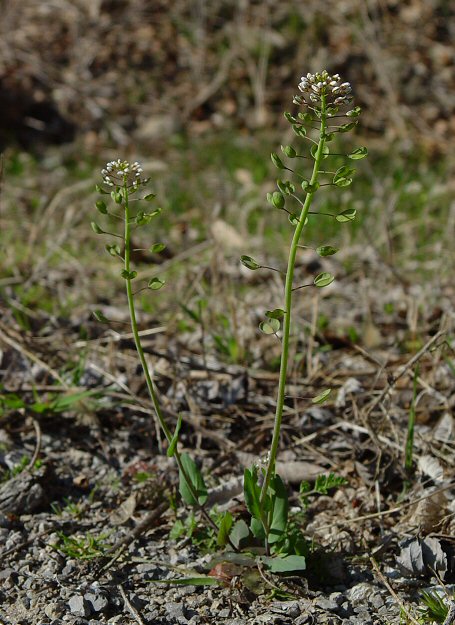Microthlaspi perfoliatum (L.) F.K. Mey.
Penny Cress

Introduced
CC = *
CW = 5
MOC = 53
© DETenaglia
Microthlaspi perfoliatum (L.) F.K. Mey.Penny Cress | |
 |
Introduced CC = * CW = 5 MOC = 53 |
© DETenaglia |
|
Family - Brassicaceae Habit - Taprooted annual forb, glabrous and somewhat glaucous throughout, not producing an odor when bruised or crushed. Stems - Ascending to erect, to 35 cm, glabrous, glaucous. Leaves - Alternate and with usually few basal leaves at flowering, glabrous, glaucous. Basal leaves with petioles to 2 cm long, glabrous. Stem leaves 1-4 cm long, reduced upward, sessile, clasping the stem with mostly rounded auricles, ovate to narrowly oblong, entire or with a few shallow teeth.
Inflorescence - Terminal raceme, compact in flower, elongating in fruit to 10 cm. Pedicels to 4 mm long in flower, expanding in fruit to 6 mm, glabrous.
Flowers - Sepals 4, distinct, 1.0-1.5 mm long, ovate, green with whitish margins. Petals 4, 1.5-3.0 mm long, white, glabrous, spatulate to oblanceolate. Stamens 6, didynamous. Filaments 1.2 mm long, glabrous, white. Style absent or very short, to 0.2 mm long. Ovary green, superior, compressed, ovoid to rotund, 1 mm long.
Fruits - Silicles 3.0-5.5 mm long, obcordate, the margins broadly winged toward the tip, the apical notch shallow and wider than deep, glabrous. Seeds 2-4 per locule, 1.3-1.5 mm long, obovate in outline, the surface light orange to tan, smooth or nearly so.
Flowering - March - May. Habitat - Fields, pastures, lawns, railroads, roadsides, and open, disturbed areas. Origin - Native to Europe. Lookalikes - Broadly, small species of Cardamine and Thlaspi; Capsella bursa-pastoris. Other info. - This small springtime mustard is extremely common in east-central Missouri and probably occurs everywhere in the state south of the Missouri River. Beyond Missouri its range extends mostly eastward through Virigina and Pennsylvania. Its prevalence is extremely variable. Though ubiquitous in the St. Louis region, just across the river in Illinois it is considered rare. Photographs taken at Eagle Bluffs Conservation Area, Boone County, MO., 3-7-04 (DETenaglia); also near Labadie, Franklin County, MO, 3-30-2015 (SRTurner). |